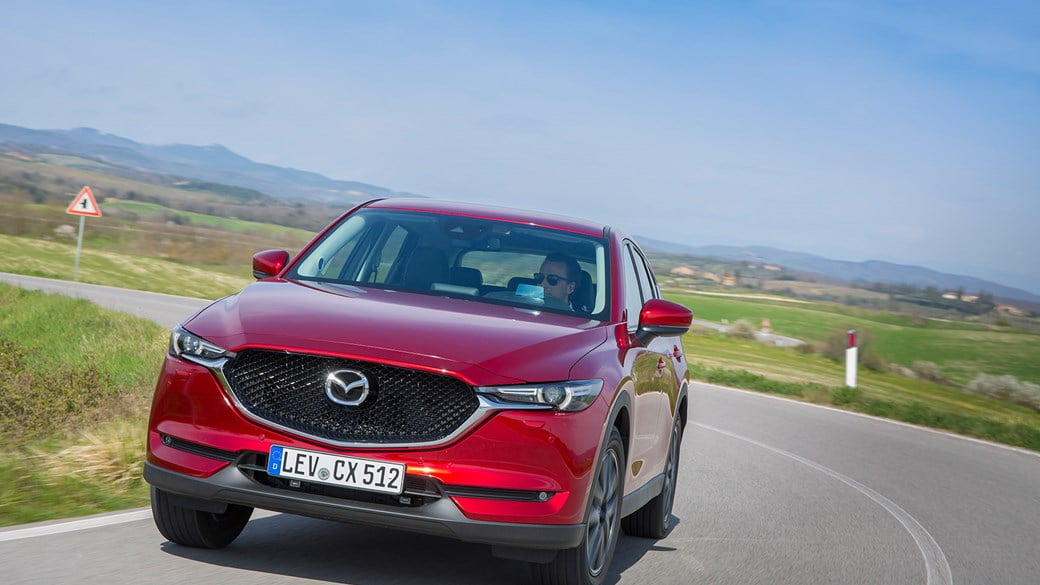
Cliches often don’t stand up to scrutiny but here’s one that is very much on-point: Mazda doesn’t make a bad car.
With a combination of eye-catching design, engaging handling and Downsize This capacity engines, the Japanese manufacturer has tapped into the priorities of the collective petrolhead consciousness to offer a pleasing alternative to mainstream austerity-autos.
It’s been doing this quietly since the launch of the original CX-5 in 2012, the first Mazda to feature the Kodo ‘Soul of Motion’ design-language and Skyactiv drivetrain and chassis tech – both founding pillars of the new-era Mazda.
Why replace the Mazda CX-5 then?
At five years old, the CX-5 that kickstarted this revolution was getting on a bit. It didn’t offer kit that was becoming everyday-standard in this segment, like a powered tailgate or proper head-up display.
And that’s a problem, because the CX-5 is the manufacturer’s most popular SUV – and its crossovers combined account for 40% of all Mazda’s sales. As you’d expect, this means the second-generation car is an exercise in marginal gains, rather than full body makeover.

So, while the engines have been carried over, there has been an extensive effort to soundproof the cabin. The bodywork and interior design have been maturely polished compared to the first-gen car, and the platform is reworked rather than brand new.
More mature sounds like they’ve made it boring…
Not at all. The CX-5 remains one of the driver’s picks in this sector. A stiffer body means better ride comfort and handling, and the addition of G-Vectoring Control improves agility, says Mazda. We’d love to say this clever system manifested itself as a marked improvement over the old car but in truth it works with a subtle touch. Which is kind of the point.
The CX-5 handles like a big hatchback, although with a degree more bodyroll than you’d get in a Mazda 2 or 3 owing to those high sides. Although it will lean in corners, body movements are kept in check for a car of this size – it feels well controlled rather than marshmallowy.
There’s plenty of grip too – especially in AWD models. Counter-intuitively, our front-driven test car seemed more responsive and keener to pick up and go on the corner exit, while the all-wheel drive version felt a bit bogged down.

The steering and gearshift (we’re testing the six-speed manual) are both great to use and reminiscent of the MX-5’s polished controls, although not quite as sharp and precise. A point of interest here: the manual override for the automatic gearbox is orientated the correct way around – downshift by pushing forwards, upshift by pulling back, like a race car’s.
Are the new 2017 Mazda CX-5 engines really the same?
Yes – save for a clever bit of tech that cuts down vibrations and resonance to make the diesel quieter at idle.
The 2.0-litre petrol needs loads of revs to get going because it doesn’t have a turbo – admirable in this day and age and fine in the MX-5, but a bit of a noisy bore in a big family car. It feels like heresy to admit it, but the twin-turbo’d 2.2-litre diesel in either 149 or 173bhp tune feels much more fitting, smooth and refined with lazy mid-range punch.

Pick this version (149bhp, 2WD, manual) for best-in-class performance and economy. It’s half a second behind the more powerful CX-5 in the benchmark sprint, but perfectly adequate for everyday use.
Verdict
It’s hard to give a definitive verdict until we’ve seen the standard equipment list and prices, but in isolation the new CX-5 improves upon the old one in all the key areas that you’d expect from a car clearly aimed at more upmarket buyers.
The new 2017 Mazda CX-5 tackles the challenges faced by all manufacturers surrounding economy and emissions not by falling back on hybridisation, but with clever engineering and its gramme strategy. Result? The CX-5 is even better to drive. Keep ‘em coming, Mazda.
[“Source-carmagazine”]





